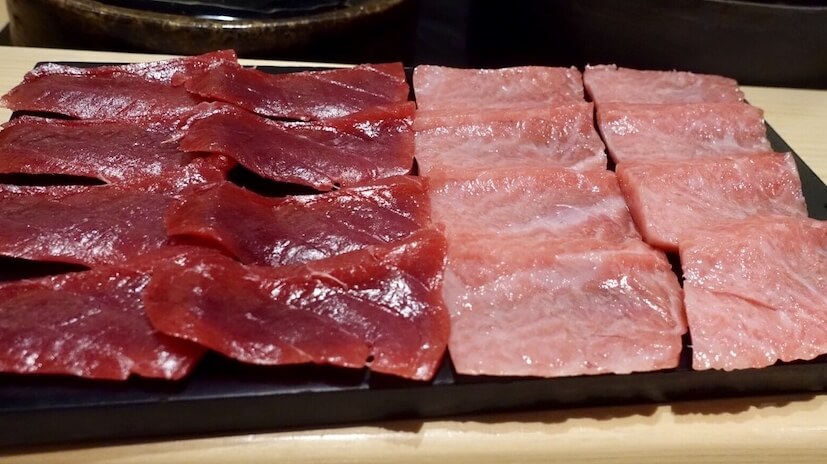Tokyo Health Centers stipulate that refrigerated cases where sushi toppings are stored should be kept at 5℃ or lower. This is to maintain the temperature of the toppings at below 10°C at which point bacterial growth is slowed.
 However, sushi chefs will remove the topping from the refrigerator and leave it standing out for a while (in the case of tuna, the fat will melt at around 23℃). They do this because if the topping is cold, it becomes difficult to taste the essential nature of the fish. The temperature of the shari is best at human skin temperature (around 36℃) to maximize the taste and sweetness of the rice. However, the ideal temperature differs very slightly depending on the topping.
However, sushi chefs will remove the topping from the refrigerator and leave it standing out for a while (in the case of tuna, the fat will melt at around 23℃). They do this because if the topping is cold, it becomes difficult to taste the essential nature of the fish. The temperature of the shari is best at human skin temperature (around 36℃) to maximize the taste and sweetness of the rice. However, the ideal temperature differs very slightly depending on the topping.
Some of Japan’s top sushi chefs pay meticulous attention to temperature—down to the exact degree. Hideshi Namba, the head chef of Sushi Nanba in Hibiya, is renowned for controlling both the topping (neta) and the sushi rice (shari) temperatures to within 1°C. He uses a laser thermometer to ensure that each piece is served at the most flavorful combination of warmth and texture.
For example, he serves fatty tuna (toro) with the topping at around 24°C and the rice at around 40°C, enhancing the melting of fat and the release of umami. Shellfish like scallop or clam are served cooler to preserve delicacy, while kuruma prawn is carefully matched to body temperature—approximately 38°C—for maximum sweetness and a harmonious mouthfeel.
You can check the general guidelines below for the ideal temperature range of common sushi toppings. This data was obtained from professional cookbooks.
| Sushi Topping | Ideal Temperature | Description |
|---|---|---|
| White Fish (Tai, Hirame) | Approx. 18–22°C | Delicate flavor and aroma are best preserved at slightly cool room temperature. |
| Squid (Sumii-ka, Aori-ika) | Approx. 20°C | Sweetness and texture stand out at this temperature. Too cold makes it too firm. |
| Shellfish (Scallop, Akagai) | Approx. 20–23°C | Room temperature enhances sweetness and ocean aroma. |
| Salmon (including Toro Salmon) | Approx. 23–25°C | Fat melts smoothly, creating a rich mouthfeel when served slightly warm. |
| Tuna (Chutoro, Otoro) | Approx. 23–26°C | High fat content melts around this range, maximizing umami and texture. |
| Silver-skinned Fish (Aji, Saba) | Approx. 20–23°C | Vinegared fish benefit from being served close to room temperature for balance. |
| Sea Urchin (Uni) | Approx. 18–20°C | Too warm dulls aroma; too cold mutes sweetness. Slightly cool is ideal. |
| Salmon Roe (Ikura) | Approx. 15–18°C | Cooler temperature preserves the firm texture and prevents melting. |
| Kuruma Prawn | Approx. 36°C (body temperature) | Served warm, just like the sushi rice, for harmony and natural sweetness. |
| Conger Eel (Anago) | Approx. 40–42°C | Served warm to bring out the aroma and sweetness of the sauce and fat. |
Overseas, there are laws that state that sushi must be served at 10℃ or lower. This ignores that sushi is best enjoyed at skin temperature. Serving it straight out of the refrigerator makes it no better than purchasing takeout sushi from the supermarket.
Related contents: Sushi Nanba
